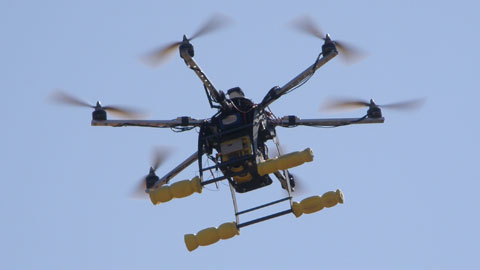Drone technology developed to work in emergencies

07/04/2015
With the objective of developing a system prototype based on the use of drones as a support service to the firefighters of Catalonia when managing emergencies, the Directorate General for Fire Prevention, Extinguishing and Civil Safety (Direcció General de Prevenció, Extinció d’Incendis i Salvaments) signed an agreement with the Universitat Autònoma de Barcelona (UAB), the Universitat Politècnica de Catalunya (UPC) and the Computer Vision Centre (CVC).
The collaboration agreement, which will last three years (and extended annually), will allow developing devices and technology which could facilitate the decision-making process for fire commanders when dealing with an emergency. It would help, for example, in a wildfire in which updated maps could be acquired with images of how the fire advances, map the hot spots in which the fire is already controlled and discover the difficult-to-access areas. Images of inaccessible zones could also be captured and recorded from the air. In the long term, researchers aim to develop a system which could help when searching for people.
The UAB research group, made up of the Aeronautics and Logistics Unit of the Department of Telecommunications and Engineering Systems, will be responsible for the development and configuration of the aircrafts, as well as for the planning and execution of missions in different scenarios of interest. At the moment, the use of individual remotely piloted aircrafts (RPA) is programmed, but given the research knowledge and experience of the group, there will be the possibility of incorporating the execution of missions based on cooperative multi-RPA systems in a second phase.
The UPC, through its Barcelona School of Informatics' InLab (InLab FIB), will work on the software needed for all the utilities provided in the prototype by making use of the knowledge acquired with the FireFight model of real-time monitoring of emergency devices. The software will help firefighters make decisions on the actions they will take.
The UAB's CVC will be in charge of working on the processing and analysis of video images and photographs taken by the drone.
The government's firefighters will let the technicians working on the project participate in several different practice operations with the aim of testing the prototype. They will also accompany research groups in real fire situations.
In addition, the firefighters will provide their personal experience to help determine which technical characteristics and requirements are essential for the devices, as well as their expertise in coordinating emergency situations. This will in turn guarantee the applicability of the technology.
With regard to emergencies and their management, the drones will mainly be used in wildfires, given that these dynamic scenarios can easily scale to large magnitudes. The drone is designed to offer additional information to the general vision of the emergency and allows not only to speed up the process of taking decisions by the commanders who are at the site of the emergency, but also to make a general assessment of the situation while at the site of the emergency.
This past 10 March testing began by using this new technology in forest fires. Testing was done in Olivella (El Garraf) while a prescribed burning was carried out by the firefighters' Forest Actions Group (Grup d’Actuacions Forestals). Two flights were conducted in automatic mode, lasting five and ten minutes each, and both visible and infrared images were recorded simultaneously. The posterior analysis of the images helped researchers from the different institutions participating in the agreement to conduct a more precise calibration of the equipment and software.